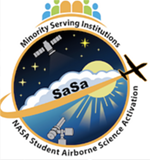



The SaSa program will draw on NASA SMD’s (Science Mission Directorate’s) unique assets (aircraft, aircraft sensors and experts) to create an effective learning environment, where students will take part in a paid summer internship for eight weeks (years 2-5). They will receive experiential learning experience delivered by NASA subject matter experts and guest lecturers, covering different topics such as basic remote sensing principles, basic atmospheric thermodynamics, atmospheric stability, and data analysis. Students will also receive professional development training including scientific abstract writing, comprehensive literature review, networking and professional presentations (oral and poster). More importantly, students will be connected to bridge programs (e.g., NASA internships, NASA Pathways, and NASA Student Airborne Research Program (SARP), and receive guidance and science counseling to keep them motivated and engaged in the Earth Science field through graduation, and ready to take the next step, including proceeding to a graduate school or taking up a STEM career.
The SaSa project has three main objectives with:
The SaSa program will draw on NASA SMD’s (Science Mission Directorate’s) unique assets (aircraft, aircraft sensors and experts) to create an effective learning environment, where students will take part in a paid summer internship for eight weeks (years 2-5).